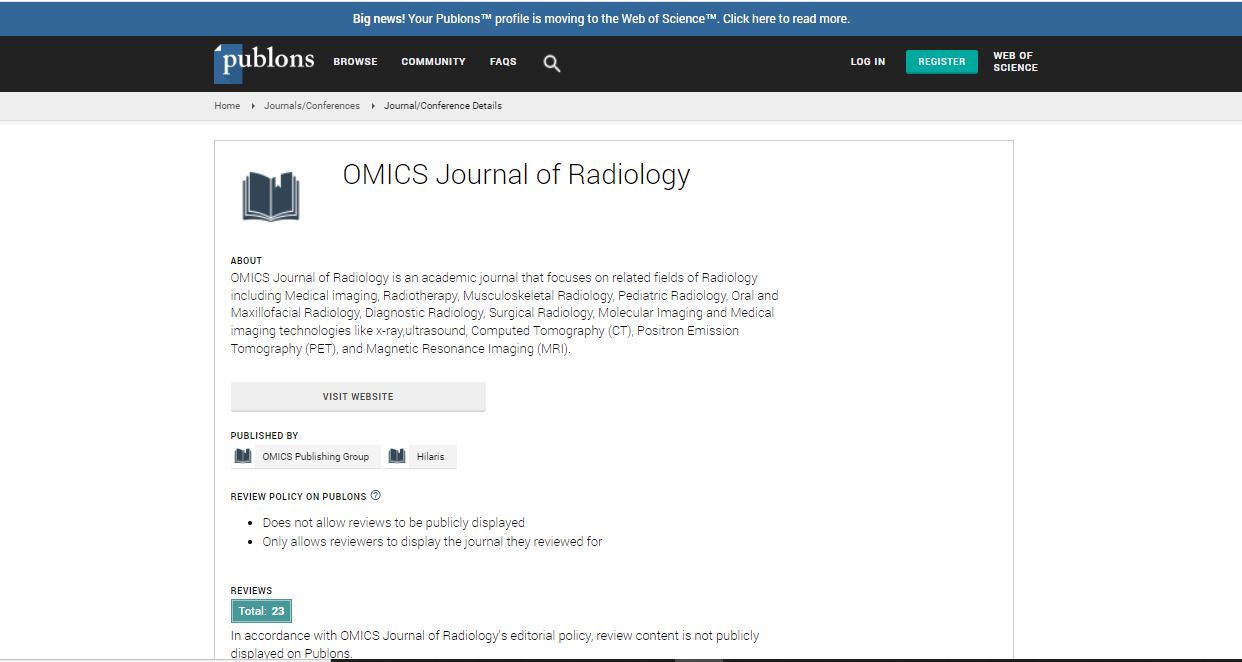Our Group organises 3000+ Global Conferenceseries Events every year across USA, Europe & Asia with support from 1000 more scientific Societies and Publishes 700+ Open Access Journals which contains over 50000 eminent personalities, reputed scientists as editorial board members.
Open Access Journals gaining more Readers and Citations
700 Journals and 15,000,000 Readers Each Journal is getting 25,000+ Readers
Google Scholar citation report
Citations : 551
Journal of Radiology received 551 citations as per Google Scholar report
Journal of Radiology peer review process verified at publons
Indexed In
- Index Copernicus
- Google Scholar
- Open J Gate
- Genamics JournalSeek
- ResearchBible
- Electronic Journals Library
- RefSeek
- Hamdard University
- EBSCO A-Z
- OCLC- WorldCat
- SWB online catalog
- Virtual Library of Biology (vifabio)
- Publons
- Geneva Foundation for Medical Education and Research
- ICMJE
Useful Links
Share This Page
New advances in functional MR imaging of the lungs and brain using hyperpolarized and inert gases
3rd International Conference on Radiology and Imaging
Mitchell S Albert
Lakehead Univeristy, Canada
Keynote: OMICS J Radiol
Abstract
Hyperpolarized (HP) agents have the potential to vastly improve MRI sensitivity for the diagnosis and management of various diseases. The polarization of 3He and 129Xe can be enhanced by a factor of up to 100,000, which enables direct detection of the HP agent with no background signal. Conventional 1H MR imaging of the lungs is very challenging, particularly due to the low proton density in lung tissue. HP gas MRI, using 3He or 129Xe, can be used to obtain high-quality images of the lung structure and function. Inert fluorinated gas 19F MRI is a new pulmonary imaging modality that may be able to provide images and functional information similar to HP gas MRI. Inert fluorinated gases are nontoxic, abundant, inexpensive, and do not need to be hyperpolarized prior to their use in MRI, and their short T1 allows for signal averaging within a breath-hold. HP 129Xe is a potentially valuable MR tracer for functional brain imaging due to its high solubility in the blood and brain, and its large chemical shift range. We published the first results using HP 129Xe brain imaging techniques for the measurement of cerebral ischemia and cortical brain function in rats. HP 129Xe can also be used in biosensors for molecular MR imaging, and delivered to a target by means of dedicated molecular cage systems that can encapsulate xenon and bind to biological sites of interest using a targeting moiety, such as an antibody or a ligand, which enables detection of a specific biomarker.Biography
Albert is a Research Chair at the Thunder Bay Regional Research Institute and Lakehead University. He is Director of MRI Research, Director of the Hyperpolarized Gas MRI Laboratory, a Scientist at TBRRI, and Professor of Chemistry at Lakehead University. Prior to this he was Associate Professor of Radiology at the Harvard Medical School. Dr. Albert is one of the inventors and pioneers of hyperpolarized gas MRI, and holds 9 patents on its development. He received the United States Presidential Award from President Clinton for this invention and received a CAREER award from the National Science Foundation (NSF).
Email: albertmi@tbh.net

 Spanish
Spanish  Chinese
Chinese  Russian
Russian  German
German  French
French  Japanese
Japanese  Portuguese
Portuguese  Hindi
Hindi 
